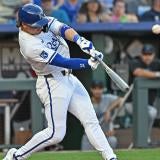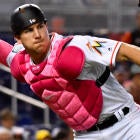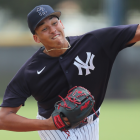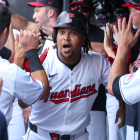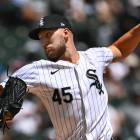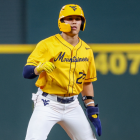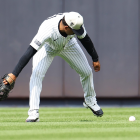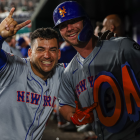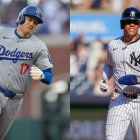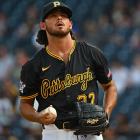Amid all the $300 million rumors swirling around Bryce Harper and Manny Machado, another name has been a constant source of speculation this hot stove season. This player can't come close to Harper or Machado in terms of star power and name value. Yet due to his own talents and the sudden dearth of stars at his position, this player could deliver comparable value to this year's two top-shelf free agents over the next two seasons.
J.T. Realmuto, it's time for your closeup.
The Marlins catcher has leapt to the top of the list of this winter's trade candidates, particularly with the Mets and Cleveland reportedly tamping down talk of possible deals for Noah Syndergaard and Corey Kluber. The Astros and Dodgers have been cited as potential front-runners for a Realmuto trade. The Braves are in the mix with rumors also pegging the Rays, Padres, and even Reds as possible dance partners. The biggest obstacle for a trade to happen might be the Marlins' insistence that they acquire one or more major leaguers with three or more controllable years of big league service time as part of a Realmuto trade.
All things considered, the Marlins' request -- whether it plays out with controllable major leaguers or top prospects -- looks highly reasonable. While none of Realmuto's line-by-line numbers jumps out at you, his all-around game has made him a hot commodity, as well as the best catcher in baseball.
Playing in 125 games last season, Realmuto batted .277/.340/.484, numbers that work out to 26 percent better than league average after adjusting for pitcher-friendly Marlins Park. Combine those excellent offensive numbers with defensive contributions that rated right at league average according to Baseball Prospectus' Fielding Runs Above Average (which counts pitch-framing, pitch-blocking, and throwing stats), and you get a very good catcher.
But context is everything. While Realmuto might not hit like peak Mike Piazza or catch like peak Pudge Rodriguez, his solid bat, playable defense, and durability still added up to better than four Wins Above Replacement (using whichever version of that stat you prefer). Size up Realmuto's all-around numbers both last season and over the past three seasons, and you get a jarring result: He delivered more value than Harper, the guy who might be on the verge of earning more money than any baseball player, ever.
That comparison, more than anything, highlights how Harper stands to become uberwealthy largely due to his potential, and his Ted Williamsian 2015 season. More relevant to Realmuto's trade value is how he fares compared to the rest of the league's catchers. In 2018, he crushed them all.
More than just present-day value, Realmuto's two years of team control offer the potential for more. At 27 years old, he should be right in his prime, still well short of the games-played thresholds that often sap the ability of overworked catchers.
With each win on the open market going for about $9 million, and Realmuto projecting to stick around four Wins Above Replacement in his age-28 and -29 seasons, he'd be worth north of $35 million a year, if teams truly paid players exactly as many dollars as they're worth. Even if that wouldn't happen, Realmuto still looks like a gigantic value, given that his 2019 arbitration award projects around $7 million (and we could then peg his 2020 arbitration award at about twice that 2019 number).
On the skills front, Realmuto has improved in multiple areas over the past three years, most notably with his plate discipline -- pumping up his walk rate while also swinging less often at pitches out of the strike zone and falling into fewer 0-1 counts. Also rising are his power (his .208 Isolated Power mark was a career best, putting him on par with Jose Abreu and ahead of sluggers like Justin Upton) and baserunning value (he stole just three bases in 2018, but does such a great job advancing an extra 90 feet on the basepaths that he delivered more value with his legs than Jose Altuve). It's tough to find a good historical comp for Realmuto, for one simple reason: Very few catchers have so few weaknesses in their game.
Realmuto's 2018 catching peers had no such problems showing off their weaknesses. Between veterans showing signs of wear and younger catchers falling short of expectations, last season ranked as one of the worst of all time for backstops.
How bad have things become for today's catchers? For some answers, we turned to CBS Sports research maestro John Fisher. Using Wins Above Replacement, Fisher found two notable trends. First, 2018's group of catchers was unusually lousy. Second, Realmuto stood head and shoulders above his peers, another relative rarity. Fisher notes:
- This past season marked the third time in four years that the top 10 catchers combined for a WAR below 30 -- it was over 30 for 12 years straight before that, and in 22 of the previous 23 seasons.
- This past season was the sixth time this century that the top catcher (in this case Realmuto) was at least one full win better than the second catcher (also happened in 2015, 2012, 2009, 2006 and 2005).
- This past season was the third straight year that the best catcher (in this case Realmuto) had fewer than five Wins Above Replacement -- the best catcher had at least five Wins Above Replacement for 10 straight years before that.
- This past season snapped a 10-year streak of cumulative catcher WAR being 50 or better, the second-longest streak of its kind in major-league history. It was only the fourth time in 23 full seasons since the strike that cumulative catcher WAR fell below 50.
Though the drop in catcher effectiveness was felt across the league, six receivers stood out as significant letdowns compared to expectations, and their own career numbers.
Few players at any position have fallen harder over the past few years than Buster Posey. The 2012 National League Most Valuable Player was still a .300-hitting, 20-homer-smashing beast as of 2014, no mean feat for a hitter toiling at offense-snuffing AT&T Park. But Posey's power has nosedived over the years, reaching a nadir of just five long balls last year, with a big, fat goose egg in the final 45 games he played. Once an elite defensive backstop, advanced metrics had him as just a tick above average with the glove last year too.
Posey was one of several over-30 catchers feeling the pain in 2018. Thirty-two-year-old Jonathan Lucroy was once a two-way terror, an elite defensive catcher who also raked in 2012, 2014, and 2016. But Lucroy hit like a pitcher and caught like a peanut vendor last year, batting a meager .241/.291/.325 while posting some of the worst defensive numbers in the league. Four-time All-Star Russell Martin remained one of the most patient hitters in the league, but also batted an abysmal .194 at age 35, resulting in him losing his starting job to upstart Danny Jansen by year's end.
The younger set had its own share of problems. Six-time All-Star Salvador Perez's .235 batting average and .274 OBP were both career lows. Willson Contreras went from rising star to massive letdown, though some of that could've been anticipated: His 21 homers in 2017 plunged to just 10 in 2018, driven by his home run-to-flyball rate plummeting from a flukishly high 26 percent to just 9 percent last season.
Then there was Gary Sanchez. The Baby Bomber looked poised to ride shotgun with Aaron Judge and Giancarlo Stanton in their annihilation of AL pitching. Instead, Sanchez sank from .278/.345/.531, 33-homer behemoth to .186/.291/.406, 18-homer dud. Add that offensive stinkbomb to Sanchez's notoriously terrible pitch-blocking skills, and you could see why the Yankees at least kicked the tires on Realmuto this winter, despite Sanchez being younger, and owning light-tower power.
Throw in Yadier Molina turning 36 last season, and free agent Yasmani Grandal (who ranked second last season in catcher WAR) playing historically awful defense last postseason, and the shine on Realmuto only grows. Now we wait to see if any team will pay the Marlins' asking price, whether before or after the Harper-and-Machado market finally, mercifully plays itself out.






